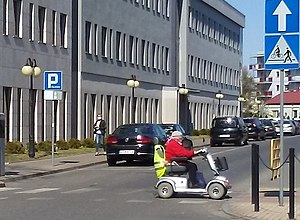This article provides insufficient context for those unfamiliar with the subject. (May 2022) |
This article needs attention from an expert in disability. The specific problem is: Tone is problematic. (May 2023) |

Geography of disability[1] is a multi-disciplinary branch of human geography which studies the experiences of people with disabilities and the extent to which disability in a population can be influenced by its geographical location. Potential components of studies in a geographical analysis include the environment, politics, incidental and additional supports, and the socio-economic landscape of the region being examined. This field has become increasingly important as policymakers have become aware of the need to ensure equal access to community resources for all individuals, regardless of mobility challenges.
According to the World Health Organization, about 15 percent of the world's population lives with some form of disability; two to four percent have significant difficulties in functioning.[2] The WHO report indicates that poverty, government investment in medical services, and individual access to health care impact disability rates in developed regions. A distinction between impairment and disability is also made.
- ^ "Geography of Disability - Geography - Oxford Bibliographies - obo". Retrieved 2018-09-06.
- ^ World Health Organisation (December 14, 2011). "World Report on Disability". Retrieved 17 July 2022.